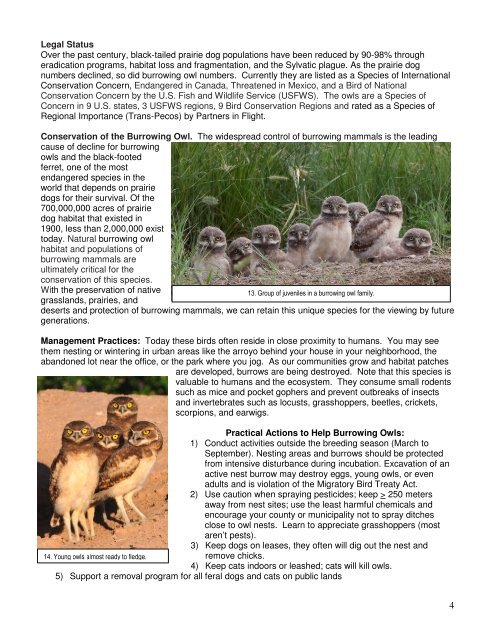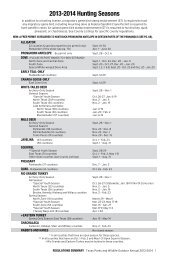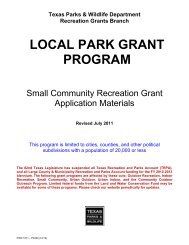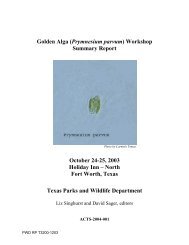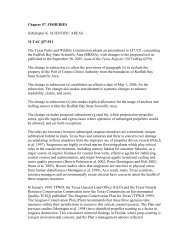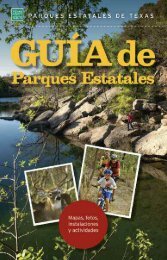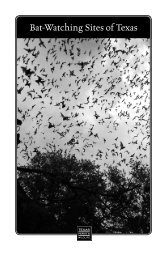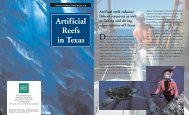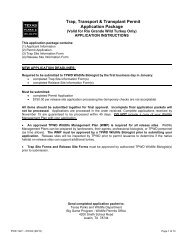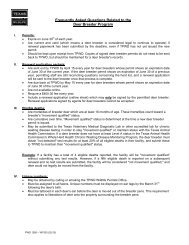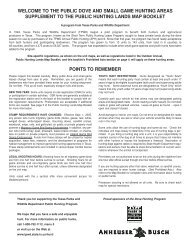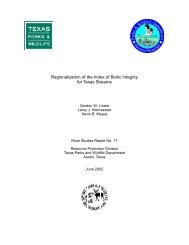1 burrowing owls of the trans-pecos and panhandle regions of texas
1 burrowing owls of the trans-pecos and panhandle regions of texas
1 burrowing owls of the trans-pecos and panhandle regions of texas
You also want an ePaper? Increase the reach of your titles
YUMPU automatically turns print PDFs into web optimized ePapers that Google loves.
Legal Status<br />
Over <strong>the</strong> past century, black-tailed prairie dog populations have been reduced by 90-98% through<br />
eradication programs, habitat loss <strong>and</strong> fragmentation, <strong>and</strong> <strong>the</strong> Sylvatic plague. As <strong>the</strong> prairie dog<br />
numbers declined, so did <strong>burrowing</strong> owl numbers. Currently <strong>the</strong>y are listed as a Species <strong>of</strong> International<br />
Conservation Concern, Endangered in Canada, Threatened in Mexico, <strong>and</strong> a Bird <strong>of</strong> National<br />
Conservation Concern by <strong>the</strong> U.S. Fish <strong>and</strong> Wildlife Service (USFWS). The <strong>owls</strong> are a Species <strong>of</strong><br />
Concern in 9 U.S. states, 3 USFWS <strong>regions</strong>, 9 Bird Conservation Regions <strong>and</strong> rated as a Species <strong>of</strong><br />
Regional Importance (Trans-Pecos) by Partners in Flight.<br />
Conservation <strong>of</strong> <strong>the</strong> Burrowing Owl. The widespread control <strong>of</strong> <strong>burrowing</strong> mammals is <strong>the</strong> leading<br />
cause <strong>of</strong> decline for <strong>burrowing</strong><br />
<strong>owls</strong> <strong>and</strong> <strong>the</strong> black-footed<br />
ferret, one <strong>of</strong> <strong>the</strong> most<br />
endangered species in <strong>the</strong><br />
world that depends on prairie<br />
dogs for <strong>the</strong>ir survival. Of <strong>the</strong><br />
700,000,000 acres <strong>of</strong> prairie<br />
dog habitat that existed in<br />
1900, less than 2,000,000 exist<br />
today. Natural <strong>burrowing</strong> owl<br />
habitat <strong>and</strong> populations <strong>of</strong><br />
<strong>burrowing</strong> mammals are<br />
ultimately critical for <strong>the</strong><br />
conservation <strong>of</strong> this species.<br />
With <strong>the</strong> preservation <strong>of</strong> native<br />
grassl<strong>and</strong>s, prairies, <strong>and</strong><br />
13. Group <strong>of</strong> juveniles in a <strong>burrowing</strong> owl family.<br />
deserts <strong>and</strong> protection <strong>of</strong> <strong>burrowing</strong> mammals, we can retain this unique species for <strong>the</strong> viewing by future<br />
generations.<br />
Management Practices: Today <strong>the</strong>se birds <strong>of</strong>ten reside in close proximity to humans. You may see<br />
<strong>the</strong>m nesting or wintering in urban areas like <strong>the</strong> arroyo behind your house in your neighborhood, <strong>the</strong><br />
ab<strong>and</strong>oned lot near <strong>the</strong> <strong>of</strong>fice, or <strong>the</strong> park where you jog. As our communities grow <strong>and</strong> habitat patches<br />
are developed, burrows are being destroyed. Note that this species is<br />
valuable to humans <strong>and</strong> <strong>the</strong> ecosystem. They consume small rodents<br />
such as mice <strong>and</strong> pocket gophers <strong>and</strong> prevent outbreaks <strong>of</strong> insects<br />
<strong>and</strong> invertebrates such as locusts, grasshoppers, beetles, crickets,<br />
scorpions, <strong>and</strong> earwigs.<br />
Practical Actions to Help Burrowing Owls:<br />
1) Conduct activities outside <strong>the</strong> breeding season (March to<br />
September). Nesting areas <strong>and</strong> burrows should be protected<br />
from intensive disturbance during incubation. Excavation <strong>of</strong> an<br />
active nest burrow may destroy eggs, young <strong>owls</strong>, or even<br />
adults <strong>and</strong> is violation <strong>of</strong> <strong>the</strong> Migratory Bird Treaty Act.<br />
2) Use caution when spraying pesticides; keep > 250 meters<br />
away from nest sites; use <strong>the</strong> least harmful chemicals <strong>and</strong><br />
encourage your county or municipality not to spray ditches<br />
close to owl nests. Learn to appreciate grasshoppers (most<br />
aren’t pests).<br />
3) Keep dogs on leases, <strong>the</strong>y <strong>of</strong>ten will dig out <strong>the</strong> nest <strong>and</strong><br />
14. Young <strong>owls</strong> almost ready to fledge.<br />
remove chicks.<br />
4) Keep cats indoors or leashed; cats will kill <strong>owls</strong>.<br />
5) Support a removal program for all feral dogs <strong>and</strong> cats on public l<strong>and</strong>s<br />
4


